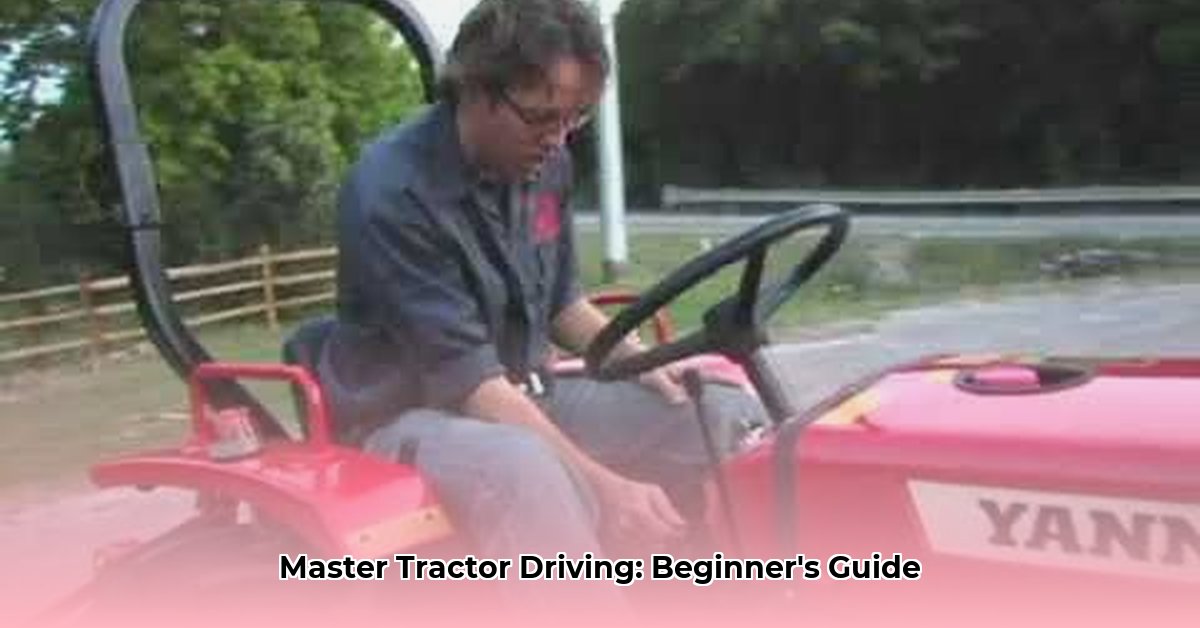
This comprehensive guide provides a step-by-step approach to safely operating a tractor, focusing on pre-operational checks, safety procedures, and basic operation. Whether you're a complete beginner or have some experience, mastering these skills will ensure a safe and productive experience. Remember, prioritizing safety is paramount when working with agricultural machinery. For more specific Kubota tractor instructions, check out this helpful guide: Kubota Tractor Guide.
Pre-Operational Checks: Ensuring Tractor Readiness
Before starting your tractor, a thorough pre-operational check is essential. This prevents potential mechanical issues and safeguards your safety. This checklist should be followed for every use. Think of it as your tractor's pre-flight checklist.
Fluid Levels: Check engine oil, coolant, transmission fluid, and hydraulic fluid levels. Use the dipstick or sight glasses provided and add fluids as needed to the correct levels specified in your owner's manual. Using the wrong fluid type can cause serious damage.
Tire Pressure: Ensure tires are properly inflated according to your owner's manual. Underinflation reduces traction and increases the risk of damage; overinflation can lead to blowouts. Use a tire pressure gauge for accurate readings.
Lights and Signals: Verify all lights (headlights, brake lights, turn signals) are functioning correctly. Proper lighting is vital for visibility, especially during low-light operation.
Safety Equipment: Inspect your seatbelt, Roll Over Protective Structure (ROPS), and other safety features to ensure they are in good working order and properly secured. A malfunctioning safety device needs immediate professional attention. The PTO (Power Take-Off) shield must be correctly in place to prevent accidental contact with moving parts.
External Inspection: Walk around the tractor and visually inspect for any loose parts, damage, leaks, or obstructions. A thorough visual check can prevent many potential issues.
Brake Test: Test the brakes before starting the engine to ensure they respond properly and consistently. Spongy or unresponsive brakes require immediate attention from a qualified mechanic.
Safety Procedures: Prioritizing Personal Protection
Operating a tractor demands unwavering focus on safety. Never compromise on safety protocols.
Protective Clothing: Always wear sturdy work boots, long pants, and gloves. Avoid loose clothing that could get caught in moving parts. Depending on the task, eye protection (safety glasses or goggles) and hearing protection (earplugs or earmuffs) are also recommended.
Seatbelt Use: Use your seatbelt at all times.
Situational Awareness: Maintain constant awareness of your surroundings, including obstacles, other people, and animals. Avoid distractions and operate the tractor only when you are alert and focused.
Emergency Procedures: Familiarize yourself with the location and operation of the emergency shut-off switch. Know what to do in the event of an accident, including how to contact emergency services.
OSHA Compliance: Familiarize yourself with relevant OSHA regulations for operating agricultural machinery. These standards provide vital guidelines for safe operation.
Starting and Stopping the Tractor: A Controlled Process
Starting and stopping a tractor requires a smooth, controlled approach. Jerky movements can lead to loss of control.
Starting (Manual Transmission): Engage the parking brake firmly. Fully depress the clutch pedal. Start the engine. Slowly and gradually release the clutch pedal, allowing the tractor to move forward at a low speed.
Starting (Automatic Transmission): Engage the parking brake. Select the appropriate gear (usually the lowest). Start the engine. Slowly release the parking brake.
Stopping: Gradually reduce speed using the throttle. Then, smoothly and firmly apply the brakes. Always engage the parking brake once you've completely stopped.
Operating the Tractor: Mastering the Controls
Smooth operation minimizes risks. The following points guide proper operation.
Steering: Use gentle steering inputs, avoiding sharp turns, especially at higher speeds. Adjust your grip and steering technique according to the terrain.
Braking: Use the brakes progressively. Avoid harsh braking, which can lead to loss of control, especially on slopes.
Gear Shifting (Manual): Fully depress the clutch pedal before shifting gears. Shift carefully, and gradually release the clutch to avoid jerking or stalling.
Gear Shifting (Automatic): Choose the appropriate gear using the gear selector. Pay attention to the engine's RPMs and the load.
Using Attachments: Expanding Capabilities Safely
Attaching and operating implements demands precise procedures.
Hitching and Unhitching: Always follow the manufacturer's instructions carefully. Improper hitching can be extremely dangerous.
Safe Usage: Understand the limitations and operating parameters of each attachment before use. This includes weight and speed limits. Always disconnect attachments when not in use.
Troubleshooting and Maintenance: Keeping Your Tractor Running Smoothly
Regular maintenance prevents breakdowns and ensures safe operation. Consult your owner's manual for a detailed maintenance schedule. Addressing issues promptly prevents escalating problems.
Common Issues:
- Engine Won't Start: Check the battery, fuel system, and starter motor.
- Engine Smoke (White, Blue, Black): White smoke often indicates coolant leaks; blue smoke, burning oil; black smoke, rich fuel mixture. These problems require professional assessment.
- Unusual Noises: Inspect for loose parts or worn bearings.
Conclusion: Continuous Learning for Safe Tractor Operation
This guide provides a foundation for safe tractor operation. Remember, continuous learning and practice are essential. Always refer to your owner's manual and seek help from experienced operators or professionals when needed. Prioritizing safety ensures a productive and hazard-free experience. Safe operation is not just a matter of following steps, it's a mindset that demands your consistent attention to detail.